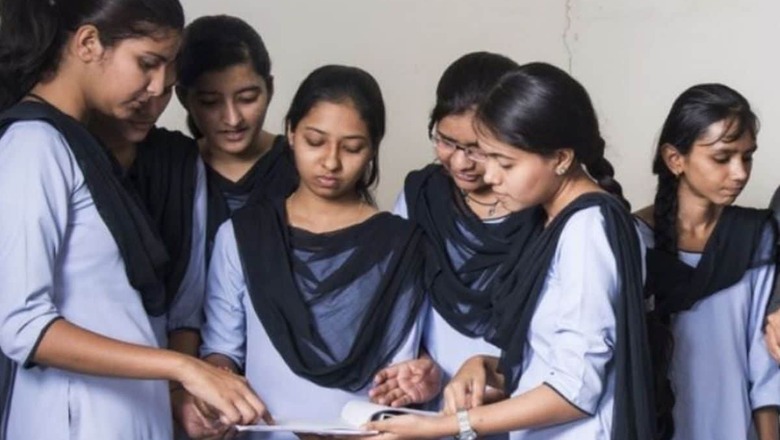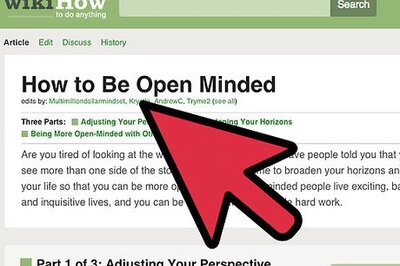
views
In a move that will benefit thousands of students, the Centre has mandated that all study materials for school and higher education courses should be digitally available in Indian languages soon. This means students will soon have access to textbooks in their own native languages, making the learning process much easier.
Education Ministry has asked UGC, AICTE, NCERT, NIOS, IGNOU, and the heads of IITs, Central Universities and NITs, to ensure the availability of study materials in Indian languages in all courses within the next three years. UGC, AICTE, and the Department of School Education have also been directed to address this matter to state school boards and universities.
The directive aligns well with the recommendations of the National Education Policy (NEP), emphasising the promotion of multilingualism in education across all levels. The goal is to afford students the opportunity to study in their mother tongue, fostering improved learning outcomes by eliminating language barriers. Studying in one’s own language is seen as providing a natural space for innovative thinking.
Focus on Indian languages
Under the leadership of Prime Minister Narendra Modi, the Union government has implemented various measures to encourage regional languages in education, introducing technical and professional courses.
To foster indigenous languages and Indian Knowledge Systems (IKS) among the youth, the Union Budget 2023-24 has earmarked Rs 300.7 crore for national institutions dedicated to promoting Indian languages. This reflects a 20 per cent increase from the allocation in 2022-23 and a doubling of the fund for the IKS scheme. The grants to institutes for the promotion of Indian languages have risen to Rs 300.7 crore in 2023-24, compared to Rs 250 crore in the financial year 2022-23, marking an almost 70 per cent increase from Rs 176.5 crore in 2021-22.
Beneficiary institutions, such as Central Sanskrit University, Kendriya Hindi Sansthan, National Council for Promotion of Urdu Language, National Council for Promotion of Sindhi Language, Central Institute of Classical Tamil, and National Initiative for Quality Higher Education in Indian Languages, have witnessed increased funding.
For the Central Institute of Indian Languages (CIIL), Mysore, dedicated to the promotion of all Indian languages, including Kannada, Telugu, Malayalam, and Odia, the fund allocation has risen to Rs 53.61 crore in 2023-24 from Rs 43.50 crore in the revised estimate for 2022-23.
The University Grants Commission (UGC) has established an apex committee to collaborate with Indian authors in developing textbooks at the undergraduate and postgraduate levels in various Indian languages and disciplines. These digital-format books will be accessible to students through the national digital library, as announced in the budget.
Furthermore, the allocation for the directorate of Hindi has increased to Rs 39.47 crore in 2023-24 from Rs 36 crore in the current fiscal year. This directorate, comprising four regional centres, is dedicated to the propagation and development of Hindi as a link language. In the implementation of recommendations, a focused initiative is underway to produce high-quality learning materials in Indian languages. This comprehensive effort spans the creation of textbooks, workbooks, videos, plays, poems, novels, and magazines.
Facilitating this endeavour is the establishment of the Indian Institute of Translation and Interpretation (IITI), which will engage numerous scholars proficient in Indian languages, subject experts, and specialists in translation and interpretation. The integration of technology will be pivotal in supporting these translation and interpretation initiatives. An integral strategy for establishing an equitable education system involves teaching in the mother tongue or regional language. The Ministry of Education is actively striving to develop a system based on principles of fairness and inclusion.
Ensuring fairness requires addressing obstacles arising from the personal and social circumstances of students, with the goal of removing hindrances to their full academic potential. Simultaneously, in promoting inclusion through the use of the mother tongue or regional language, there is a concerted effort to establish a basic minimum standard of education. This standard aims to eliminate all disparities and cultivate a more inclusive educational environment.
Another initiative to promote the Indian languages was through the propagation of culture. On December 20, the government launched an online repository called ‘IKS Wiki’ to provide in-depth research and knowledge about Indian culture and traditions. The vision behind the repository is to provide the people with knowledge about the traditions and culture of India in a simplified way that could be understood by the common man. The initiative focuses on subjects that are part of the knowledge system developed over many years by people in India. This knowledge has been passed down through writings, manuscripts, oral traditions, and customs.
National Education Framework
The higher education system has historically neglected the rightful significance of Indian languages. Nevertheless, with the introduction of the National Education Policy (NEP) 2020, the government has actively supported Indian languages by providing the necessary funds and opportunities.
The NEP-2020 strongly emphasises leveraging the multilingual nature of Bharat as a significant asset and strength for the socio-cultural, economic, and educational development of the nation. Efficient utilisation of this multilingual asset, particularly through content creation in local languages, is envisioned to enhance its contribution to the goal of ‘Viksit Bharat’ and the aspiration to transform the country into a developed nation by 2047.
Over the past two years, the government has actively pursued this objective by utilising the AI-based ‘Anuvadini’ app for translating engineering, medical, law, UG, PG, and skill books. These translated books are accessible on the e-KUMBH portal. In the school education ecosystem, study materials are also made available in multiple Indian languages, encompassing over 30 languages on DIKSHA. Furthermore, competitive exams such as JEE, NEET, and CUET are now conducted in 13 Indian languages, further promoting linguistic diversity in education. NEP 2020 serves as a response to the Macaulay education system introduced by the British to influence the thoughts of Indians during colonisation.
Ten states have embraced regional languages as the medium of instruction for engineering courses, and numerous initiatives are underway to promote the use of Indian languages in higher education. The objective is to establish a multi-disciplinary higher education institute in every district. To elevate India as a global study destination, the NEP advocates for the establishment of a Multidisciplinary Education and Research University (MERU). The focus of NEP extends beyond education to encompass character building, emphasising that a nation is shaped by its people rather than solely by infrastructure or industries.
The current NEP advocates for higher education institutions to employ the mother tongue/local language as a medium of instruction or introduce bilingual programs. The objective is to deliver high-quality education to a broader student population, leading to an increase in the Gross Enrolment Ratio (GER) in higher education. Additionally, the goal is to enhance the strength, usage, and vibrancy of all Indian languages. Encouraging private institutions to embrace Indian languages as a medium of instruction or offer bilingual programs aligns them with government institutions.
The teachers’ training program, including the four-year Bachelor of Education dual degree, is also conducted in a bilingual format. This approach facilitates the training of teachers across various subjects, with science and math teachers adopting a bilingual teaching methodology.
National Curriculum Framework and promotion of Indian languages
Similarly, following the government’s push towards the promotion of Indian languages, the National Curriculum Framework (NCF) for School Education 2023 underwent a notable change from its initial draft proposals released for public input in April last year. The Centre, releasing the NCF, mandated the instruction of three languages during classes 9-10, including two Indian languages, and two languages during classes 11-12, with one being an Indian language.
In alignment with the National Education Policy (NEP) 2020, the NCF emphasises the importance of learning three languages, aiming to foster multilingualism and appreciation for India’s diverse linguistic tapestry.
The NCF advocates the learning of three languages – R1, R2, and R3 – during school years. R1, typically the regional language, is intended to cultivate a deeper connection to culture and identity. The goal is for students to achieve independent reading and writing proficiency in R1 by age 8 (Grade 3), similar literacy in R2 by age 11 (Grade 6), and in R3 by age 14 (Grade 9). The curriculum aims for academic linguistic proficiency in all three languages by age 15 (Grade 10), with at least two being native Indian languages.
The curriculum’s intent is to instill a sense of pride, belonging, and rootedness in cultural heritage through language education. By offering at least one Indian language as an instructional medium until Grade 12 and providing options for language choices, the NCF promotes multilingualism, cultural awareness, and international engagement.
The benefits of learning three languages include enhanced cognitive skills, heightened cultural sensitivity, better job prospects, improved communication abilities, and expanded travel and study opportunities. The NCF 2023’s emphasis on trilingual education marks a substantial stride toward nurturing multilingualism, equipping students for a globalised world, and enriching India’s linguistic landscape.
Education and Digitalisation
The government of India envisions and shapes e-learning with digital pedagogy as a long-term strategy in the education sector. The recent initiative to digitise learning resources at the school level in Indian languages aligns with this vision.
Today, the Ministry of Education is actively working on the concept of learning by all, with all, and for all, within the framework aimed at adapting an enhanced learning experience for students. Under this framework, the government has initiated several programs and established Digital Education Guidelines with standards to address digital education for equitable learning in India. Digital education involves learning where technology and digital tools play a vital role.
This broad ed-tech model of education facilitates student learning from any part of the country. The government has proposed various channels to provide extensive sources of digital education through different initiatives. Every state/Union Territory has taken various inclusive steps to bridge the digital divide and promote digital literacy among students. Some state governments have initiated the provision of smartphones and tablets to encourage digital education.
The government has undertaken several prominent initiatives for digital education:
PM E-Vidhya: Announced on May 17, 2020, this comprehensive program aims to integrate digital and online education with existing programs for broader reach and access to e-learning. It targets nearly 25 crore school students nationwide.
DIKSHA: Launched in 2017 with the vision of ‘One Nation, One Digital Platform,’ DIKSHA is a national platform for grades 1 to 12, accessible through a web portal or mobile app. It provides curriculum-specific e-content, assignments, and courses for educators.
SWAYAM Prabha TV: This initiative comprises 32 channels focusing on educational programs under the theme ‘One Class, One Channel.’ Aligned with DIKSHA, the curriculum and topics are organised similarly for asynchronous usage. It has collaborations with Tata Sky and Airtel for broadcasting educational programs.
VidyaDaan: Launched in April 2020, VidyaDaan aims to solicit donations and contributions for digital education resources from educational institutions, private players, and individuals. States like Assam, Goa, Kerala, Odisha, UP, Punjab, Maharashtra, Gujarat, Telangana, and Chandigarh, along with CBSE and NCERT, actively contribute content to DIKSHA through VidyaDaan.
E-Pathshala: Focusing not only on students but also teachers and parents, E-Pathshala offers e-textbooks with 3500+ curriculum content in English, Sanskrit, Urdu, and Hindi. It can be accessed through a web portal or mobile app.
The Government of India is committed to transforming and expanding education for all students in remote areas by providing digital and technical support for education with a single click. Through ICT education initiatives, the government has revitalised the education sector in India, eliminating the digital divide and showcasing the quality and digital reach of its programs for a brighter future for students in the country.
Catalysing Linguistic Renaissance
The Government of India’s initiatives to promote Indian languages in education mark a transformative commitment. Mandating digital study materials in native languages, increased funding for language institutions, and the emphasis on multilingual education underpin a comprehensive approach.
The National Education Policy (NEP) 2020 catalyses this linguistic renaissance, leveraging technology through initiatives like Anuvadini, the AI-based app and conducting exams in multiple Indian languages. The establishment of the Indian Institute of Translation and Interpretation (IITI) adds a technological dimension to language promotion.
The government’s commitment to teaching in regional languages and its digital education programs reflect a strategic vision for an inclusive, equitable, and culturally rooted education system. This linguistic revival is not just a policy but a celebration of India’s rich cultural diversity, ensuring a vibrant linguistic tapestry for generations to come.
The views expressed in this article are those of the author and do not represent the stand of this publication.



















Comments
0 comment